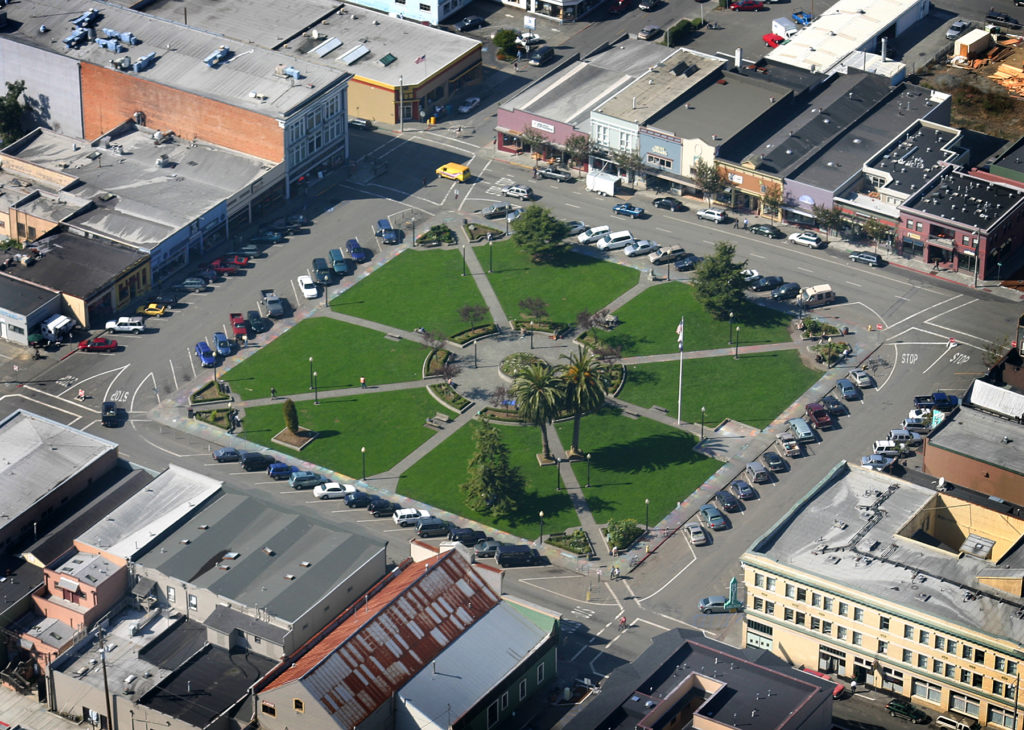By Krystle Heaney, AICP, January 18, 2021
The northern California coast is noted for its wild and untamed nature.
In Mendocino, Humboldt, and Del Norte counties, the rugged coastline gives way to redwood forests and diverse watersheds stretching inland to coastal mountain ranges. Travel to the area can be accomplished by infrequent air service, or via one of a handful of winding highways that make their way along river canyons that in some cases eventually give way to vast river floodplains.
This wild landscape is known for its treasures — the Lost Coast, Redwood National Park, and the Trinity Mountains range. The North Coast is also home to several rural communities, such as Mendocino, Garberville, Willow Creek, McKinleyville, and Hoopa, along with several small cities, including Fort Bragg, Point Arena, Rio Dell, Ferndale, Fortuna, Arcata, Trinidad, Crescent City, and Eureka — the largest of all — with a population of 27,000 and an area 15 square miles.

Each of these communities has its own complex set of needs for development, growth, culture, and the overall daily well-being of its citizens. Meeting those needs takes big planning ideas and approaches.
Community planning takes many forms as shown by the varying disciplines within the planning field such as transportation, open space stewardship, resource conservation, hazards management, housing development, and short- and long-term planning. In larger cities, and in more centralized and connected areas, planners often have the opportunity to hone their skills in one particular concentration. In more rural areas like the North Coast, where the smaller and more spread-out communities rely primarily on agriculture and tourism for their economic base, local planners develop skills in many different areas of community planning.
At the same time, the often-limited economic base in these communities means they cannot support a large in-house staff, so cities seek alternatives. The cities of Trinidad and Ferndale contract with private firms for planning services. That helps reduce their overhead costs while still providing the community with experienced planners to meet city needs.
The majority of North Coast cities have one or maybe two staff planners to accomplish a wide range of planning tasks. A typical day for a city planner can involve processing lot-line adjustments, responding to public inquiries about the zoning ordinance, managing grant applications, working on general plan updates, updating ordinances to meet current state legislation, and participating in regional meetings on transportation, climate change, and fire services development.
While this array of tasks may seem daunting at first, it provides an opportunity to understand the big picture and gives the staff planner a vital role in shaping the community’s future. By seeing the many different activities — from community events to struggles to maintain infrastructure, and everything in between — the planner gains in-depth knowledge of the community, its people, and their needs.
In Ferndale, for example, drainage is a major issue. As the city was built on a flat river floodplain, areas of the city at a lower elevation experience frequent flooding during the rainy season. This can affect housing development, wastewater conveyance, agricultural activities, and sensitive habitats like Francis Creek and the Salt River. In an effort to better plan for growth with these issues in mind, the city is using SB2 grant funding from the California Department of Housing and Community Development to update its drainage master plan.
Small-town planning can also lead to big accomplishments on a regional level. Living and working in a small community means you get to know many of the planners and decision-makers and work with them on a regular basis. These close working relationships can foster regional discussions on important services such as fire and emergency response.
One result in the past year was a large annexation by the Rio Dell Fire Protection District that consolidated several small volunteer fire departments in the Eel River Valley and along the Avenue of the Giants. This annexation gives the expanded District a strong economic base for a potentially higher level of service in areas that were previously struggling to provide fire protection. The volunteer fire departments now have experienced staff to help manage administrative tasks and to help recruit and retain volunteers.
Small town planning requires knowledge in a variety of areas. While that can be challenging, it can also be rewarding when you see the results of the accomplishments on the ground and acknowledged in the faces of your colleagues and neighbors.
 Krystle Heaney, AICP, is an Associate Planner with Planwest Partners in Arcata. Before joining the firm in spring 2019, she was a natural resources analyst with EN2 Resources in Placerville. Heaney is a Certified California Naturalist and holds a BA in geography from Cal State University–Sacramento.
Krystle Heaney, AICP, is an Associate Planner with Planwest Partners in Arcata. Before joining the firm in spring 2019, she was a natural resources analyst with EN2 Resources in Placerville. Heaney is a Certified California Naturalist and holds a BA in geography from Cal State University–Sacramento.

